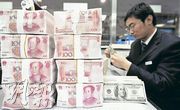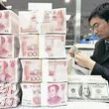
Competing Forecasts Cloud China’s Economic Conference
Publication: China Brief Volume: 8 Issue: 23
By:

The annual Central Economic Work Conference organized by the Central Committee of the Chinese Communist Party (CCP) will convene on December 8-10 in Beijing. Senior economic planners were in Beijing last week to attend a preliminary meeting that laid out an agenda for the discussion (Xinhua News Agency, December 3). According to members of the CCP politburo that attended the meeting, the central government has set next year’s economic growth target at above 8 percent (Xinhua News Agency, December 3). Chinese President Hu Jintao will chair the conference. It comes at the end of Hu’s world economic tour, which started with the G-20 Summit in Washington and continued with the 16th APEC Leaders Summit in Lima. Both conventions brought together economic leaders across the Atlantic and Pacific to address the global financial crisis. On Monday, November 30th, a report released by the National Bureau of Economic Research in Washington confirmed the United States has been in a recession since December 2007. A similarly pessimistic outlook by the World Bank predicted China’s economic growth rate to be 7.5 percent in 2009. Meanwhile, the Chinese Academy of Social Sciences (CASS), China’s premier government think-tank, released its own growth forecast for China in its "Economic Blue Paper" on December 2. Contrary to the assessment of the World Bank, the Blue Paper stated that China will sustain a 9.3 percent growth rate in 2009 based largely on “concerted world effort to counter the financial crisis” (Xinhua News Agency, December 3). Wang Tongsan, the Blue Paper’s lead coordinator and director of the Institute of Quantitative Economics at CASS, stated that the probability that China will have a growth rate at around 9 percent is above 70 percent. Wang also believes that the consumer price index, which measures the average price for goods and services, will decrease from 4 percent in 2008 to 3 percent in 2009, while risk of deflation will be low (Ming Pao, December 3).
According to multiple-Chinese media sources, the purpose of the conference will be to determine the future direction of China’s economic growth and the allocation of its proposed $586 billion domestic stimulus package. Furthermore, the meeting may produce other important decisions concerning capital, tax and financial reforms (Ming Pao, December 1). Other analysts contend that rather than announce new policies, the meeting will focus on evaluating existing policies and instruments (Xinhua News Agency, December 3).
There are a number of remarkable differences between this conference and the ones before it. First, most government policy recommendations have already been made public (i.e. $586 billion stimulus package, massive interest rate cuts, cutting gas tax, etc.) prior to the conference. Moreover, the National State Council has widened consultations in deliberating policy when examining the conditions of Chinese enterprises along the economically integrated coastal regions struck hard by the global financial tsunami. Premier Wen Jiabao hosted many seminars inviting industry representatives and scholars to solicit their advice (Ming Pao, November 24). This method of encouraging an open competition of ideas is seldom seen in Chinese decision making (Ming Pao, December 1). Some attribute the change in the government’s attitude to the recognition of the limits in solely relying on official government assessments. The case in point being the People’s Bank of China’s decision to raise bank deposit rates in June. Many Chinese economists who were aware of the global slow down cautioned against the plan, but were ignored by officials (Ming Pao, December 1).
China’s economic terrain changed rapidly in 2008. The inflation scare early in the year coupled with an overheating economy led regulators to strengthen macro-management under the banner of "two defends" (Xinhua News Agency, December 3, 2007). By mid year, the motto became "one preserve, one defend" (preserve growth, defend against inflation) and by November it changed to the singular objective of stimulating and sustaining domestic demand. These changes reflect the extent to which the Chinese economy is being pushed and pulled in different directions by both internal and external variables. If Beijing’s economic planners fall back to making decisions behind closed doors, they will undoubtedly be unable to keep up with the rapid changes in the global economy.





